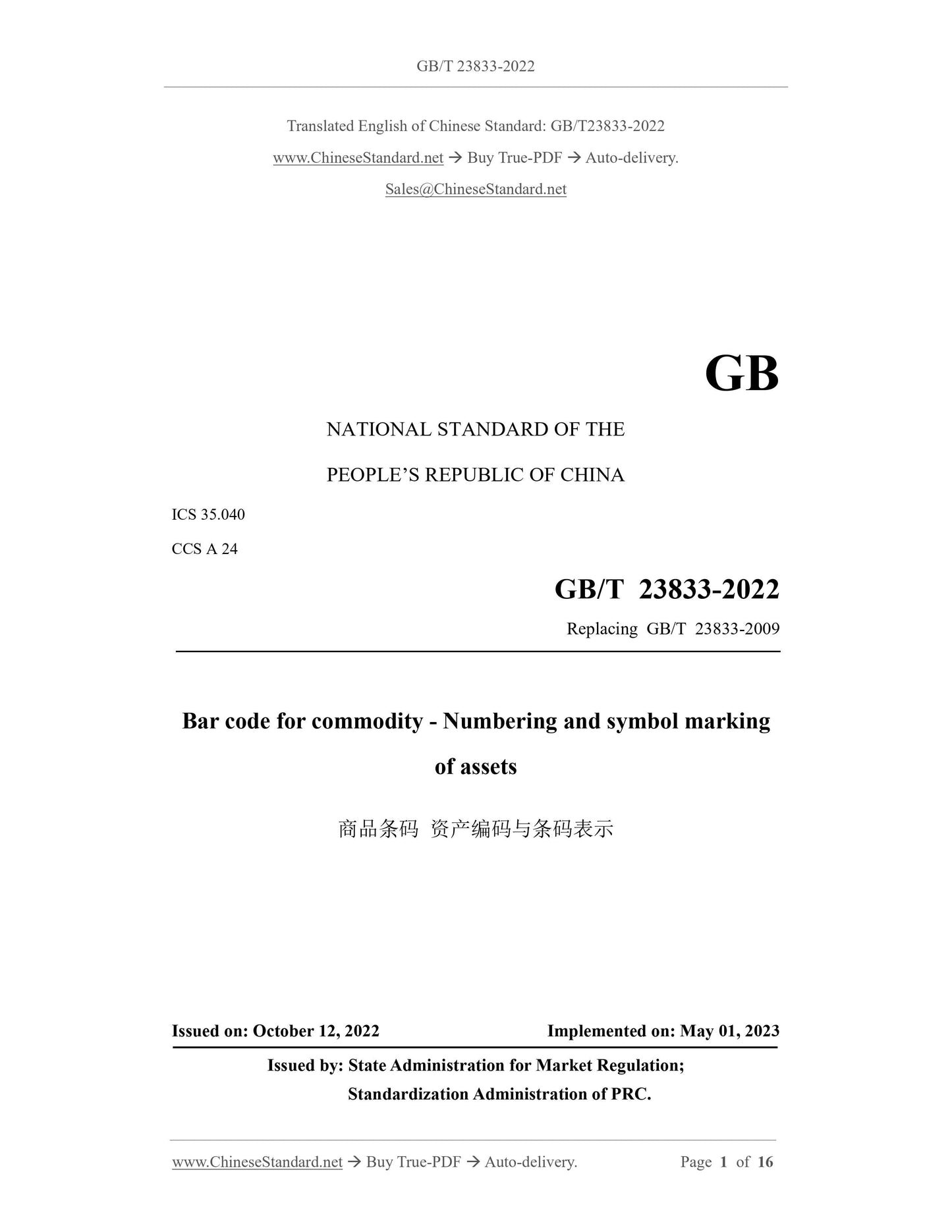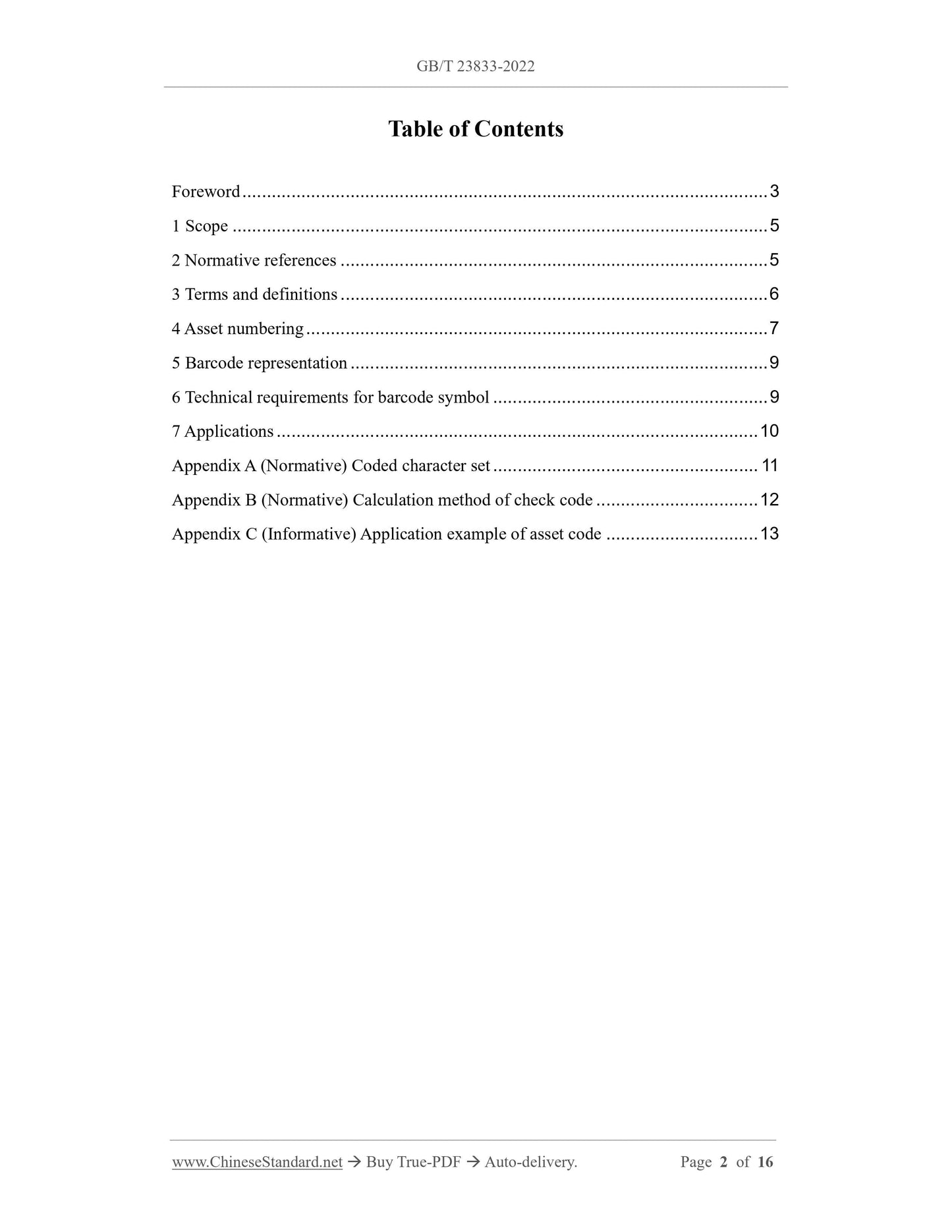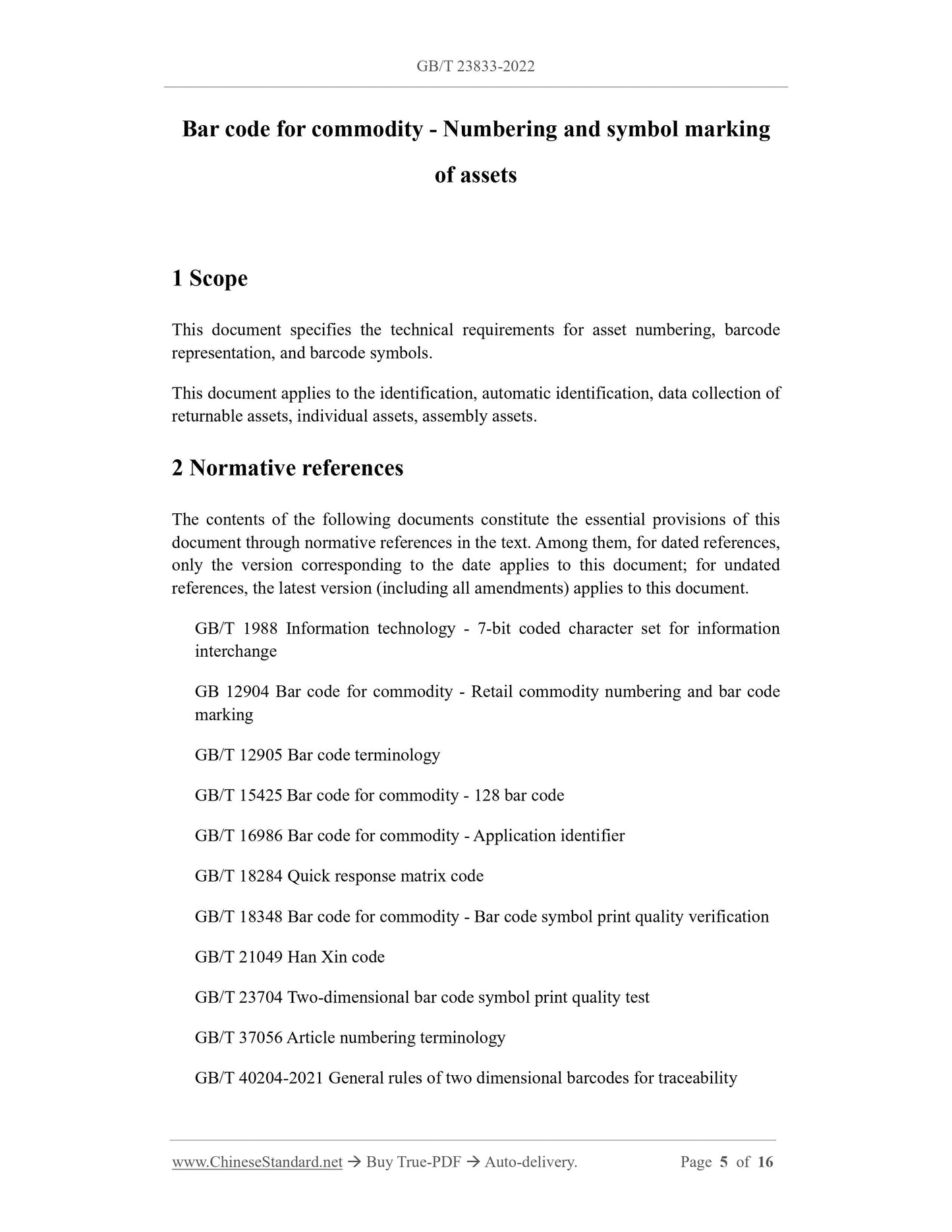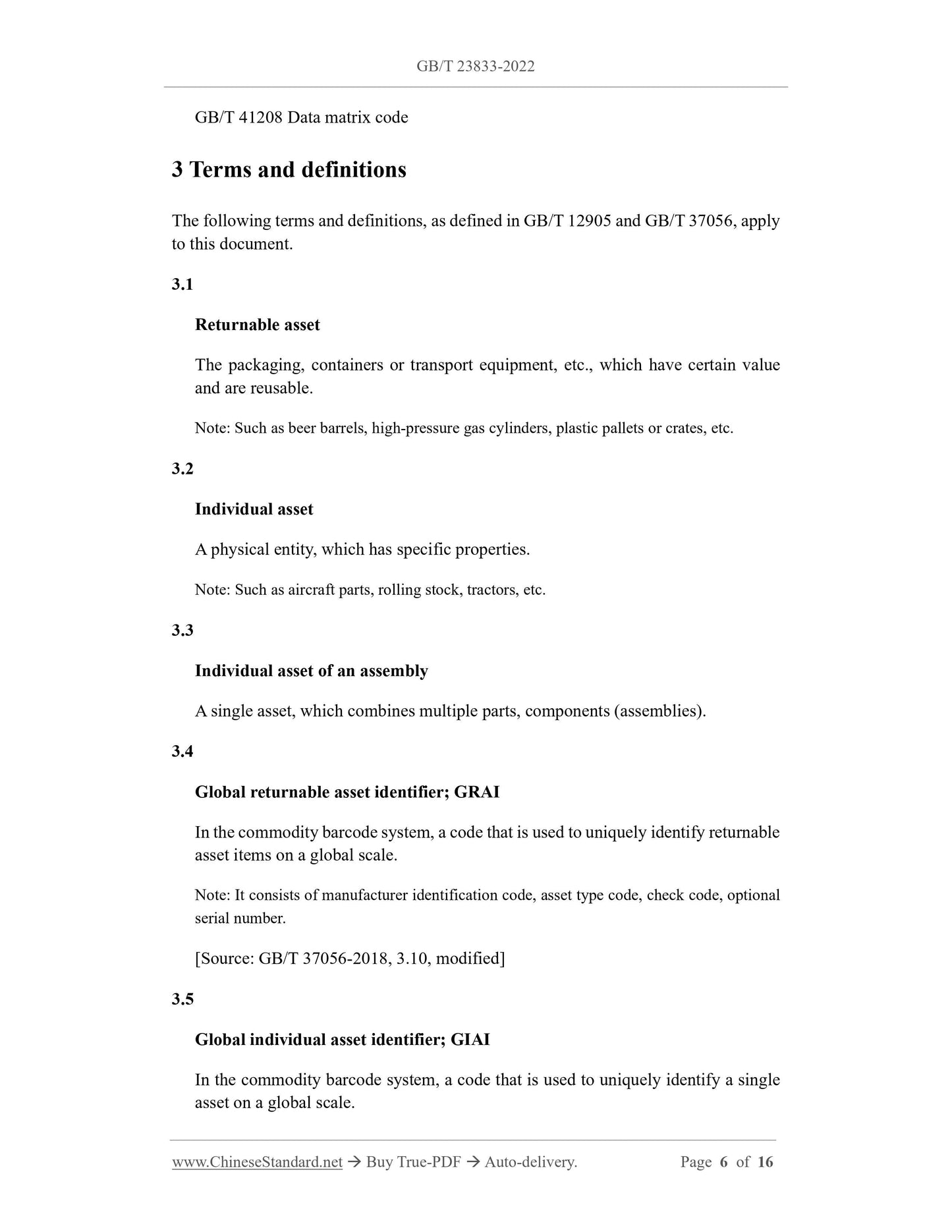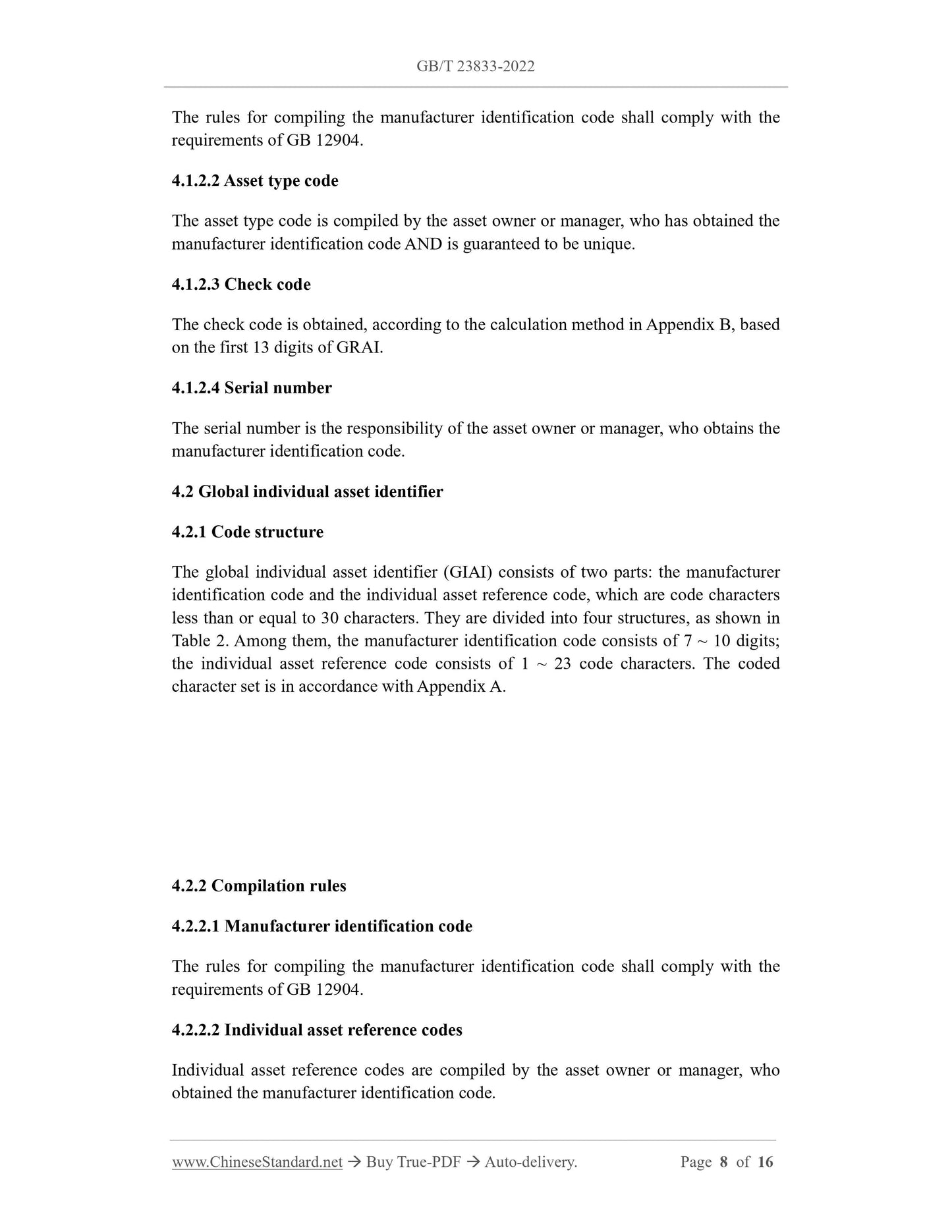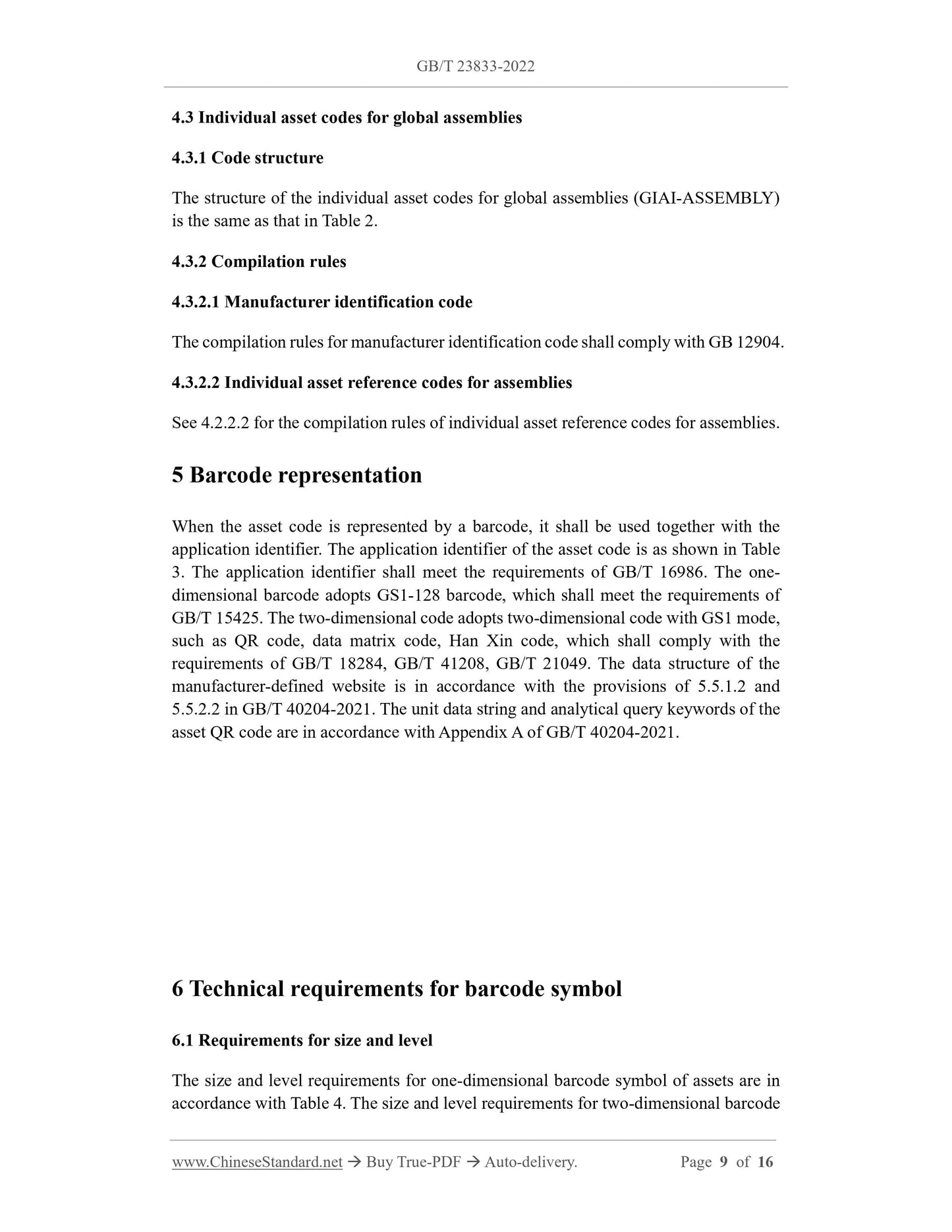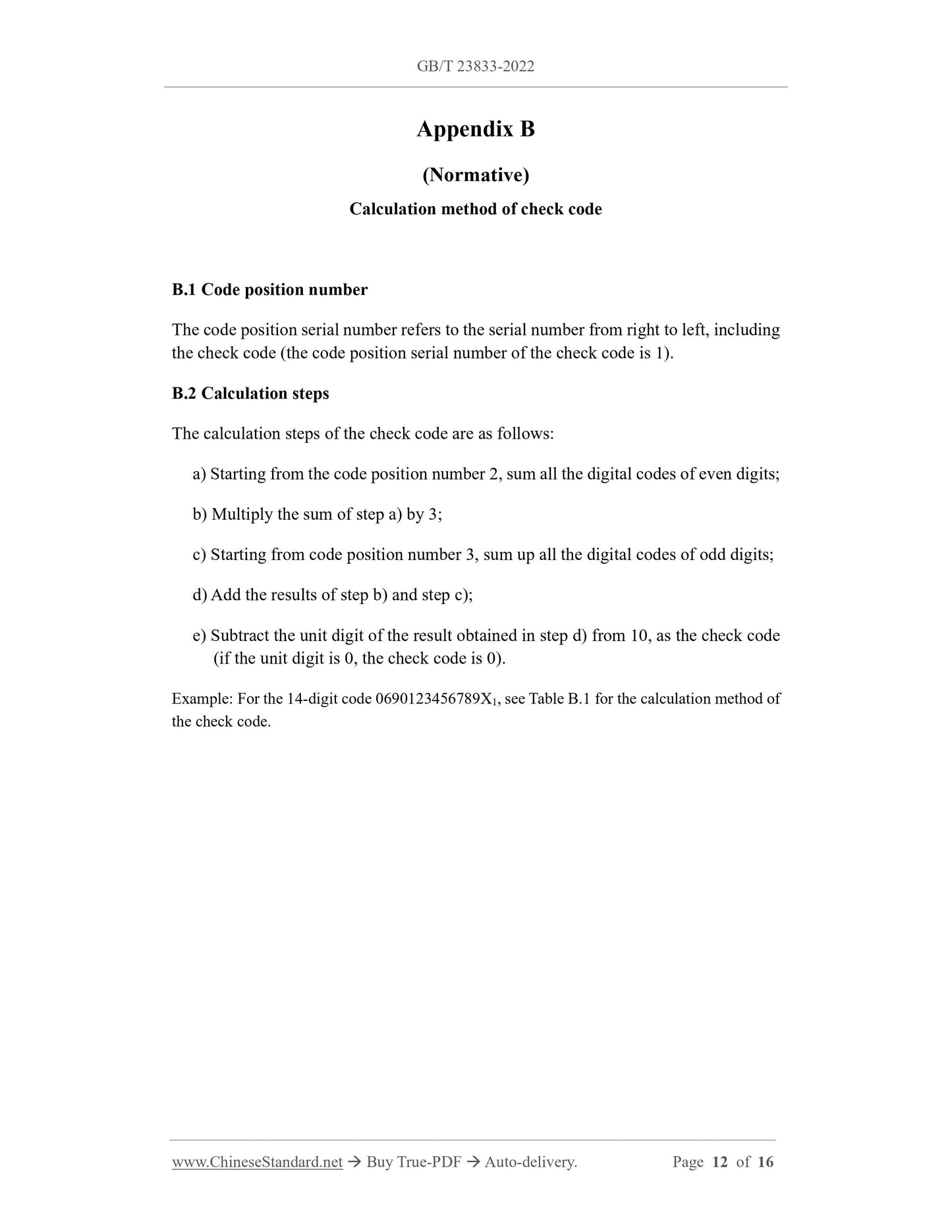1
/
of
7
www.ChineseStandard.us -- Field Test Asia Pte. Ltd.
GB/T 23833-2022 English PDF (GB/T23833-2022)
GB/T 23833-2022 English PDF (GB/T23833-2022)
Regular price
$230.00
Regular price
Sale price
$230.00
Unit price
/
per
Shipping calculated at checkout.
Couldn't load pickup availability
GB/T 23833-2022: Bar code for commodity - Numbering and symbol marking of assets
Delivery: 9 seconds. Download (& Email) true-PDF + Invoice.
Get Quotation: Click GB/T 23833-2022 (Self-service in 1-minute)
Historical versions (Master-website): GB/T 23833-2022
Preview True-PDF (Reload/Scroll-down if blank)
GB/T 23833-2022
GB
NATIONAL STANDARD OF THE
PEOPLE’S REPUBLIC OF CHINA
ICS 35.040
CCS A 24
Replacing GB/T 23833-2009
Bar code for commodity - Numbering and symbol marking
of assets
ISSUED ON: OCTOBER 12, 2022
IMPLEMENTED ON: MAY 01, 2023
Issued by: State Administration for Market Regulation;
Standardization Administration of PRC.
Table of Contents
Foreword ... 3
1 Scope ... 5
2 Normative references ... 5
3 Terms and definitions ... 6
4 Asset numbering ... 7
5 Barcode representation ... 9
6 Technical requirements for barcode symbol ... 9
7 Applications ... 10
Appendix A (Normative) Coded character set ... 11
Appendix B (Normative) Calculation method of check code ... 12
Appendix C (Informative) Application example of asset code ... 13
Bar code for commodity - Numbering and symbol marking
of assets
1 Scope
This document specifies the technical requirements for asset numbering, barcode
representation, and barcode symbols.
This document applies to the identification, automatic identification, data collection of
returnable assets, individual assets, assembly assets.
2 Normative references
The contents of the following documents constitute the essential provisions of this
document through normative references in the text. Among them, for dated references,
only the version corresponding to the date applies to this document; for undated
references, the latest version (including all amendments) applies to this document.
GB/T 1988 Information technology - 7-bit coded character set for information
interchange
GB 12904 Bar code for commodity - Retail commodity numbering and bar code
marking
GB/T 12905 Bar code terminology
GB/T 15425 Bar code for commodity - 128 bar code
GB/T 16986 Bar code for commodity - Application identifier
GB/T 18284 Quick response matrix code
GB/T 18348 Bar code for commodity - Bar code symbol print quality verification
GB/T 21049 Han Xin code
GB/T 23704 Two-dimensional bar code symbol print quality test
GB/T 37056 Article numbering terminology
GB/T 40204-2021 General rules of two dimensional barcodes for traceability
GB/T 41208 Data matrix code
3 Terms and definitions
The following terms and definitions, as defined in GB/T 12905 and GB/T 37056, apply
to this document.
3.1
Returnable asset
The packaging, containers or transport equipment, etc., which have certain value
and are reusable.
Note: Such as beer barrels, high-pressure gas cylinders, plastic pallets or crates, etc.
3.2
Individual asset
A physical entity, which has specific properties.
Note: Such as aircraft parts, rolling stock, tractors, etc.
3.3
Individual asset of an assembly
A single asset, which combines multiple parts, components (assemblies).
3.4
Global returnable asset identifier; GRAI
In the commodity barcode system, a code that is used to uniquely identify returnable
asset items on a global scale.
Note: It consists of manufacturer identification code, asset type code, check code, optional
serial number.
[Source: GB/T 37056-2018, 3.10, modified]
3.5
Global individual asset identifier; GIAI
In the commodity barcode system, a code that is used to uniquely identify a single
asset on a global scale.
The rules for compiling the manufacturer identification code shall comply with the
requirements of GB 12904.
4.1.2.2 Asset type code
The asset type code is compiled by the asset owner or manager, who has obtained the
manufacturer identification code AND is guaranteed to be unique.
4.1.2.3 Check code
The check code is obtained, according to the calculation method in Appendix B, based
on the first 13 digits of GRAI.
4.1.2.4 Serial number
The serial number is the responsibility of the asset owner or manager, who obtains the
manufacturer identification code.
4.2 Global individual asset identifier
4.2.1 Code structure
The global individual asset identifier (GIAI) consists of two parts: the manufacturer
identification code and the individual asset reference code, which are code characters
less than or equal to 30 characters. They are divided into four structures, as shown in
Table 2. Among them, the manufacturer identification code consists of 7 ~ 10 digits;
the individual asset reference code consists of 1 ~ 23 code characters. The coded
character set is in accordance with Appendix A.
4.2.2 Compilation rules
4.2.2.1 Manufacturer identification code
The rules for compiling the manufacturer identification code shall comply with the
requirements of GB 12904.
4.2.2.2 Individual asset reference codes
Individual asset reference codes are compiled by the asset owner or manager, who
obtained the manufacturer identification code.
4.3 Individual asset codes for global assemblies
4.3.1 Code structure
The structure of the individual asset codes for global assemblies (GIAI-ASSEMBLY)
is the same as that in Table 2.
4.3.2 Compilation rules
4.3.2.1 Manufacturer identification code
The compilation rules for manufacturer identification code shall comply with GB 12904.
4.3.2.2 Individual asset reference codes for assemblies
See 4.2.2.2 for the compilation rules of individual asset reference codes for assemblies.
5 Barcode representation
When the asset code is represented by a barcode, it shall be used together with the
application identifier. The application identifier of the asset code is as shown in Table
3. The application identifier shall meet the requirements of GB/T 16986. The one-
dimensional barcode adopts GS1-128 barcode, which shall meet the requirements of
GB/T 15425. The two-dimensional code adopts two-dimensional code with GS1 mode,
such as QR code, data matrix code, Han Xin code, which shall comply with the
requirements of GB/T 18284, GB/T 41208, GB/T 21049. The data structure of the
manufacturer-defined website is in accordance with the provisions of 5.5.1.2 and
5.5.2.2 in GB/T 40204-2021. The unit data string and analytical query keywords of the
asset QR code are in accordance with Appendix A of GB/T 40204-2021.
6 Technical requirements for barcode symbol
6.1 Requirements for size and level
The size and level requirements for one-dimensional barcode symbol of assets are in
accordance with Table 4. The size and level requirements for two-dimensional barcode
Appendix B
(Normative)
Calculation method of check code
B.1 Code position number
The code position serial number refers to the serial number from right to left, including
the check code (the code position serial number of the check code is 1).
B.2 Calculation steps
The calculation steps of the check code are as follows:
a) Starting from the code position number 2, sum all the digital codes of even digits;
b) Multiply the sum of step a) by 3;
c) Starting from code position number 3, sum up all the digital codes of odd digits;
d) Add the results of step b) and step c);
e) Subtract the unit digit of the result obtained in step d) from 10, as the check code
(if the unit digit is 0, the check code is 0).
Example: For the 14-digit code 0690123456789X1, see Table B.1 for the calculation method of
the check code.
GB/T 23833-2022
GB
NATIONAL STANDARD OF THE
PEOPLE’S REPUBLIC OF CHINA
ICS 35.040
CCS A 24
Replacing GB/T 23833-2009
Bar code for commodity - Numbering and symbol marking
of assets
ISSUED ON: OCTOBER 12, 2022
IMPLEMENTED ON: MAY 01, 2023
Issued by: State Administration for Market Regulation;
Standardization Administration of PRC.
Table of Contents
Foreword ... 3
1 Scope ... 5
2 Normative references ... 5
3 Terms and definitions ... 6
4 Asset numbering ... 7
5 Barcode representation ... 9
6 Technical requirements for barcode symbol ... 9
7 Applications ... 10
Appendix A (Normative) Coded character set ... 11
Appendix B (Normative) Calculation method of check code ... 12
Appendix C (Informative) Application example of asset code ... 13
Bar code for commodity - Numbering and symbol marking
of assets
1 Scope
This document specifies the technical requirements for asset numbering, barcode
representation, and barcode symbols.
This document applies to the identification, automatic identification, data collection of
returnable assets, individual assets, assembly assets.
2 Normative references
The contents of the following documents constitute the essential provisions of this
document through normative references in the text. Among them, for dated references,
only the version corresponding to the date applies to this document; for undated
references, the latest version (including all amendments) applies to this document.
GB/T 1988 Information technology - 7-bit coded character set for information
interchange
GB 12904 Bar code for commodity - Retail commodity numbering and bar code
marking
GB/T 12905 Bar code terminology
GB/T 15425 Bar code for commodity - 128 bar code
GB/T 16986 Bar code for commodity - Application identifier
GB/T 18284 Quick response matrix code
GB/T 18348 Bar code for commodity - Bar code symbol print quality verification
GB/T 21049 Han Xin code
GB/T 23704 Two-dimensional bar code symbol print quality test
GB/T 37056 Article numbering terminology
GB/T 40204-2021 General rules of two dimensional barcodes for traceability
GB/T 41208 Data matrix code
3 Terms and definitions
The following terms and definitions, as defined in GB/T 12905 and GB/T 37056, apply
to this document.
3.1
Returnable asset
The packaging, containers or transport equipment, etc., which have certain value
and are reusable.
Note: Such as beer barrels, high-pressure gas cylinders, plastic pallets or crates, etc.
3.2
Individual asset
A physical entity, which has specific properties.
Note: Such as aircraft parts, rolling stock, tractors, etc.
3.3
Individual asset of an assembly
A single asset, which combines multiple parts, components (assemblies).
3.4
Global returnable asset identifier; GRAI
In the commodity barcode system, a code that is used to uniquely identify returnable
asset items on a global scale.
Note: It consists of manufacturer identification code, asset type code, check code, optional
serial number.
[Source: GB/T 37056-2018, 3.10, modified]
3.5
Global individual asset identifier; GIAI
In the commodity barcode system, a code that is used to uniquely identify a single
asset on a global scale.
The rules for compiling the manufacturer identification code shall comply with the
requirements of GB 12904.
4.1.2.2 Asset type code
The asset type code is compiled by the asset owner or manager, who has obtained the
manufacturer identification code AND is guaranteed to be unique.
4.1.2.3 Check code
The check code is obtained, according to the calculation method in Appendix B, based
on the first 13 digits of GRAI.
4.1.2.4 Serial number
The serial number is the responsibility of the asset owner or manager, who obtains the
manufacturer identification code.
4.2 Global individual asset identifier
4.2.1 Code structure
The global individual asset identifier (GIAI) consists of two parts: the manufacturer
identification code and the individual asset reference code, which are code characters
less than or equal to 30 characters. They are divided into four structures, as shown in
Table 2. Among them, the manufacturer identification code consists of 7 ~ 10 digits;
the individual asset reference code consists of 1 ~ 23 code characters. The coded
character set is in accordance with Appendix A.
4.2.2 Compilation rules
4.2.2.1 Manufacturer identification code
The rules for compiling the manufacturer identification code shall comply with the
requirements of GB 12904.
4.2.2.2 Individual asset reference codes
Individual asset reference codes are compiled by the asset owner or manager, who
obtained the manufacturer identification code.
4.3 Individual asset codes for global assemblies
4.3.1 Code structure
The structure of the individual asset codes for global assemblies (GIAI-ASSEMBLY)
is the same as that in Table 2.
4.3.2 Compilation rules
4.3.2.1 Manufacturer identification code
The compilation rules for manufacturer identification code shall comply with GB 12904.
4.3.2.2 Individual asset reference codes for assemblies
See 4.2.2.2 for the compilation rules of individual asset reference codes for assemblies.
5 Barcode representation
When the asset code is represented by a barcode, it shall be used together with the
application identifier. The application identifier of the asset code is as shown in Table
3. The application identifier shall meet the requirements of GB/T 16986. The one-
dimensional barcode adopts GS1-128 barcode, which shall meet the requirements of
GB/T 15425. The two-dimensional code adopts two-dimensional code with GS1 mode,
such as QR code, data matrix code, Han Xin code, which shall comply with the
requirements of GB/T 18284, GB/T 41208, GB/T 21049. The data structure of the
manufacturer-defined website is in accordance with the provisions of 5.5.1.2 and
5.5.2.2 in GB/T 40204-2021. The unit data string and analytical query keywords of the
asset QR code are in accordance with Appendix A of GB/T 40204-2021.
6 Technical requirements for barcode symbol
6.1 Requirements for size and level
The size and level requirements for one-dimensional barcode symbol of assets are in
accordance with Table 4. The size and level requirements for two-dimensional barcode
Appendix B
(Normative)
Calculation method of check code
B.1 Code position number
The code position serial number refers to the serial number from right to left, including
the check code (the code position serial number of the check code is 1).
B.2 Calculation steps
The calculation steps of the check code are as follows:
a) Starting from the code position number 2, sum all the digital codes of even digits;
b) Multiply the sum of step a) by 3;
c) Starting from code position number 3, sum up all the digital codes...
Delivery: 9 seconds. Download (& Email) true-PDF + Invoice.
Get Quotation: Click GB/T 23833-2022 (Self-service in 1-minute)
Historical versions (Master-website): GB/T 23833-2022
Preview True-PDF (Reload/Scroll-down if blank)
GB/T 23833-2022
GB
NATIONAL STANDARD OF THE
PEOPLE’S REPUBLIC OF CHINA
ICS 35.040
CCS A 24
Replacing GB/T 23833-2009
Bar code for commodity - Numbering and symbol marking
of assets
ISSUED ON: OCTOBER 12, 2022
IMPLEMENTED ON: MAY 01, 2023
Issued by: State Administration for Market Regulation;
Standardization Administration of PRC.
Table of Contents
Foreword ... 3
1 Scope ... 5
2 Normative references ... 5
3 Terms and definitions ... 6
4 Asset numbering ... 7
5 Barcode representation ... 9
6 Technical requirements for barcode symbol ... 9
7 Applications ... 10
Appendix A (Normative) Coded character set ... 11
Appendix B (Normative) Calculation method of check code ... 12
Appendix C (Informative) Application example of asset code ... 13
Bar code for commodity - Numbering and symbol marking
of assets
1 Scope
This document specifies the technical requirements for asset numbering, barcode
representation, and barcode symbols.
This document applies to the identification, automatic identification, data collection of
returnable assets, individual assets, assembly assets.
2 Normative references
The contents of the following documents constitute the essential provisions of this
document through normative references in the text. Among them, for dated references,
only the version corresponding to the date applies to this document; for undated
references, the latest version (including all amendments) applies to this document.
GB/T 1988 Information technology - 7-bit coded character set for information
interchange
GB 12904 Bar code for commodity - Retail commodity numbering and bar code
marking
GB/T 12905 Bar code terminology
GB/T 15425 Bar code for commodity - 128 bar code
GB/T 16986 Bar code for commodity - Application identifier
GB/T 18284 Quick response matrix code
GB/T 18348 Bar code for commodity - Bar code symbol print quality verification
GB/T 21049 Han Xin code
GB/T 23704 Two-dimensional bar code symbol print quality test
GB/T 37056 Article numbering terminology
GB/T 40204-2021 General rules of two dimensional barcodes for traceability
GB/T 41208 Data matrix code
3 Terms and definitions
The following terms and definitions, as defined in GB/T 12905 and GB/T 37056, apply
to this document.
3.1
Returnable asset
The packaging, containers or transport equipment, etc., which have certain value
and are reusable.
Note: Such as beer barrels, high-pressure gas cylinders, plastic pallets or crates, etc.
3.2
Individual asset
A physical entity, which has specific properties.
Note: Such as aircraft parts, rolling stock, tractors, etc.
3.3
Individual asset of an assembly
A single asset, which combines multiple parts, components (assemblies).
3.4
Global returnable asset identifier; GRAI
In the commodity barcode system, a code that is used to uniquely identify returnable
asset items on a global scale.
Note: It consists of manufacturer identification code, asset type code, check code, optional
serial number.
[Source: GB/T 37056-2018, 3.10, modified]
3.5
Global individual asset identifier; GIAI
In the commodity barcode system, a code that is used to uniquely identify a single
asset on a global scale.
The rules for compiling the manufacturer identification code shall comply with the
requirements of GB 12904.
4.1.2.2 Asset type code
The asset type code is compiled by the asset owner or manager, who has obtained the
manufacturer identification code AND is guaranteed to be unique.
4.1.2.3 Check code
The check code is obtained, according to the calculation method in Appendix B, based
on the first 13 digits of GRAI.
4.1.2.4 Serial number
The serial number is the responsibility of the asset owner or manager, who obtains the
manufacturer identification code.
4.2 Global individual asset identifier
4.2.1 Code structure
The global individual asset identifier (GIAI) consists of two parts: the manufacturer
identification code and the individual asset reference code, which are code characters
less than or equal to 30 characters. They are divided into four structures, as shown in
Table 2. Among them, the manufacturer identification code consists of 7 ~ 10 digits;
the individual asset reference code consists of 1 ~ 23 code characters. The coded
character set is in accordance with Appendix A.
4.2.2 Compilation rules
4.2.2.1 Manufacturer identification code
The rules for compiling the manufacturer identification code shall comply with the
requirements of GB 12904.
4.2.2.2 Individual asset reference codes
Individual asset reference codes are compiled by the asset owner or manager, who
obtained the manufacturer identification code.
4.3 Individual asset codes for global assemblies
4.3.1 Code structure
The structure of the individual asset codes for global assemblies (GIAI-ASSEMBLY)
is the same as that in Table 2.
4.3.2 Compilation rules
4.3.2.1 Manufacturer identification code
The compilation rules for manufacturer identification code shall comply with GB 12904.
4.3.2.2 Individual asset reference codes for assemblies
See 4.2.2.2 for the compilation rules of individual asset reference codes for assemblies.
5 Barcode representation
When the asset code is represented by a barcode, it shall be used together with the
application identifier. The application identifier of the asset code is as shown in Table
3. The application identifier shall meet the requirements of GB/T 16986. The one-
dimensional barcode adopts GS1-128 barcode, which shall meet the requirements of
GB/T 15425. The two-dimensional code adopts two-dimensional code with GS1 mode,
such as QR code, data matrix code, Han Xin code, which shall comply with the
requirements of GB/T 18284, GB/T 41208, GB/T 21049. The data structure of the
manufacturer-defined website is in accordance with the provisions of 5.5.1.2 and
5.5.2.2 in GB/T 40204-2021. The unit data string and analytical query keywords of the
asset QR code are in accordance with Appendix A of GB/T 40204-2021.
6 Technical requirements for barcode symbol
6.1 Requirements for size and level
The size and level requirements for one-dimensional barcode symbol of assets are in
accordance with Table 4. The size and level requirements for two-dimensional barcode
Appendix B
(Normative)
Calculation method of check code
B.1 Code position number
The code position serial number refers to the serial number from right to left, including
the check code (the code position serial number of the check code is 1).
B.2 Calculation steps
The calculation steps of the check code are as follows:
a) Starting from the code position number 2, sum all the digital codes of even digits;
b) Multiply the sum of step a) by 3;
c) Starting from code position number 3, sum up all the digital codes of odd digits;
d) Add the results of step b) and step c);
e) Subtract the unit digit of the result obtained in step d) from 10, as the check code
(if the unit digit is 0, the check code is 0).
Example: For the 14-digit code 0690123456789X1, see Table B.1 for the calculation method of
the check code.
GB/T 23833-2022
GB
NATIONAL STANDARD OF THE
PEOPLE’S REPUBLIC OF CHINA
ICS 35.040
CCS A 24
Replacing GB/T 23833-2009
Bar code for commodity - Numbering and symbol marking
of assets
ISSUED ON: OCTOBER 12, 2022
IMPLEMENTED ON: MAY 01, 2023
Issued by: State Administration for Market Regulation;
Standardization Administration of PRC.
Table of Contents
Foreword ... 3
1 Scope ... 5
2 Normative references ... 5
3 Terms and definitions ... 6
4 Asset numbering ... 7
5 Barcode representation ... 9
6 Technical requirements for barcode symbol ... 9
7 Applications ... 10
Appendix A (Normative) Coded character set ... 11
Appendix B (Normative) Calculation method of check code ... 12
Appendix C (Informative) Application example of asset code ... 13
Bar code for commodity - Numbering and symbol marking
of assets
1 Scope
This document specifies the technical requirements for asset numbering, barcode
representation, and barcode symbols.
This document applies to the identification, automatic identification, data collection of
returnable assets, individual assets, assembly assets.
2 Normative references
The contents of the following documents constitute the essential provisions of this
document through normative references in the text. Among them, for dated references,
only the version corresponding to the date applies to this document; for undated
references, the latest version (including all amendments) applies to this document.
GB/T 1988 Information technology - 7-bit coded character set for information
interchange
GB 12904 Bar code for commodity - Retail commodity numbering and bar code
marking
GB/T 12905 Bar code terminology
GB/T 15425 Bar code for commodity - 128 bar code
GB/T 16986 Bar code for commodity - Application identifier
GB/T 18284 Quick response matrix code
GB/T 18348 Bar code for commodity - Bar code symbol print quality verification
GB/T 21049 Han Xin code
GB/T 23704 Two-dimensional bar code symbol print quality test
GB/T 37056 Article numbering terminology
GB/T 40204-2021 General rules of two dimensional barcodes for traceability
GB/T 41208 Data matrix code
3 Terms and definitions
The following terms and definitions, as defined in GB/T 12905 and GB/T 37056, apply
to this document.
3.1
Returnable asset
The packaging, containers or transport equipment, etc., which have certain value
and are reusable.
Note: Such as beer barrels, high-pressure gas cylinders, plastic pallets or crates, etc.
3.2
Individual asset
A physical entity, which has specific properties.
Note: Such as aircraft parts, rolling stock, tractors, etc.
3.3
Individual asset of an assembly
A single asset, which combines multiple parts, components (assemblies).
3.4
Global returnable asset identifier; GRAI
In the commodity barcode system, a code that is used to uniquely identify returnable
asset items on a global scale.
Note: It consists of manufacturer identification code, asset type code, check code, optional
serial number.
[Source: GB/T 37056-2018, 3.10, modified]
3.5
Global individual asset identifier; GIAI
In the commodity barcode system, a code that is used to uniquely identify a single
asset on a global scale.
The rules for compiling the manufacturer identification code shall comply with the
requirements of GB 12904.
4.1.2.2 Asset type code
The asset type code is compiled by the asset owner or manager, who has obtained the
manufacturer identification code AND is guaranteed to be unique.
4.1.2.3 Check code
The check code is obtained, according to the calculation method in Appendix B, based
on the first 13 digits of GRAI.
4.1.2.4 Serial number
The serial number is the responsibility of the asset owner or manager, who obtains the
manufacturer identification code.
4.2 Global individual asset identifier
4.2.1 Code structure
The global individual asset identifier (GIAI) consists of two parts: the manufacturer
identification code and the individual asset reference code, which are code characters
less than or equal to 30 characters. They are divided into four structures, as shown in
Table 2. Among them, the manufacturer identification code consists of 7 ~ 10 digits;
the individual asset reference code consists of 1 ~ 23 code characters. The coded
character set is in accordance with Appendix A.
4.2.2 Compilation rules
4.2.2.1 Manufacturer identification code
The rules for compiling the manufacturer identification code shall comply with the
requirements of GB 12904.
4.2.2.2 Individual asset reference codes
Individual asset reference codes are compiled by the asset owner or manager, who
obtained the manufacturer identification code.
4.3 Individual asset codes for global assemblies
4.3.1 Code structure
The structure of the individual asset codes for global assemblies (GIAI-ASSEMBLY)
is the same as that in Table 2.
4.3.2 Compilation rules
4.3.2.1 Manufacturer identification code
The compilation rules for manufacturer identification code shall comply with GB 12904.
4.3.2.2 Individual asset reference codes for assemblies
See 4.2.2.2 for the compilation rules of individual asset reference codes for assemblies.
5 Barcode representation
When the asset code is represented by a barcode, it shall be used together with the
application identifier. The application identifier of the asset code is as shown in Table
3. The application identifier shall meet the requirements of GB/T 16986. The one-
dimensional barcode adopts GS1-128 barcode, which shall meet the requirements of
GB/T 15425. The two-dimensional code adopts two-dimensional code with GS1 mode,
such as QR code, data matrix code, Han Xin code, which shall comply with the
requirements of GB/T 18284, GB/T 41208, GB/T 21049. The data structure of the
manufacturer-defined website is in accordance with the provisions of 5.5.1.2 and
5.5.2.2 in GB/T 40204-2021. The unit data string and analytical query keywords of the
asset QR code are in accordance with Appendix A of GB/T 40204-2021.
6 Technical requirements for barcode symbol
6.1 Requirements for size and level
The size and level requirements for one-dimensional barcode symbol of assets are in
accordance with Table 4. The size and level requirements for two-dimensional barcode
Appendix B
(Normative)
Calculation method of check code
B.1 Code position number
The code position serial number refers to the serial number from right to left, including
the check code (the code position serial number of the check code is 1).
B.2 Calculation steps
The calculation steps of the check code are as follows:
a) Starting from the code position number 2, sum all the digital codes of even digits;
b) Multiply the sum of step a) by 3;
c) Starting from code position number 3, sum up all the digital codes...
Share
